Birçok WordPress kullanıcısı, bilgisayarlarında yerel bir sunucu kullanarak web siteleri üzerinde çalışmayı tercih eder. Bu, değişiklikleri çevrimiçi olarak kullanıma sunmadan önce web siteniz üzerinde özel olarak çalışmanıza olanak tanır.
Sonunda, çevrimiçi ziyaretçilerin erişimine açmak için web sitenizi canlı bir sunucuya taşımanız gerekecektir. Bu geçiş, web sitenizin canlı sitede düzgün çalışmasını sağlamak için çok önemlidir.
Birçok yerel web sitesi üzerinde çalıştık, bu nedenle içeriği canlı web sitelerine aktarmanın en kolay yolunu öğrenmemiz gerekiyordu.
Bu makalede, WordPress’in yerel bir sunucudan canlı bir siteye nasıl taşınacağına ilişkin adım adım talimatlar vereceğiz.
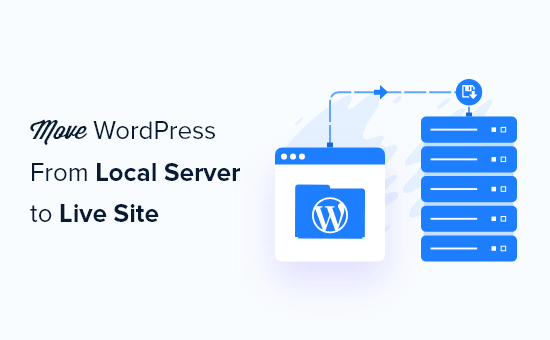
WordPress’i Neden Yerel Sunucudan Canlı Siteye Taşımalısınız?
WordPress blogunuzu yerel bir sunucuda oluşturmak, web sitenizdeki değişiklikleri ziyaretçileri etkilemeden test etmenin güvenli bir yoludur.
Web sitenizi mükemmelleştirmeyi tamamladığınızda, bir sonraki adım yerel sunucunuzdan canlı bir siteye geçmektir.
Sitenizi yerel bir sunucudan canlı bir siteye taşımanın iki yolunu gösterelim.
İlk yöntem bir WordPress geçiş eklentisi kullanır ve yeni başlayanlar için önerilir.
İkinci yöntemde, WordPress’i yerel bir sunucudan canlı bir siteye manuel olarak nasıl taşıyacağınızı göstereceğiz.
Sizin için en uygun olan yöntemi seçebilirsiniz:
WordPress Sitenizi Taşımadan Önce
WordPress’i yerel bir sunucudan canlı bir sunucuya taşımak için birkaç şeye sahip olmanız gerekir.
İlk olarak, bilgisayarınızdaki yerel bir sunucuda (localhost olarak da adlandırılır) çalışan bir WordPress siteniz olduğunu ve buna tam erişiminiz olduğunu varsayıyoruz.
Ardından, bir alan adına ve web barındırma hizmetine sahip olmanız gerekir.
Kötü veya ücretsiz web barındırma sağlayıcılarıyla başlayıp pişman olan yeni başlayanlardan sayısız hikaye duyduk. Deneyimlerimize göre, doğru barındırma sağlayıcısını seçmek herhangi bir web sitesinin başarısı için kritik öneme sahiptir.
Kararınızı kolaylaştırmak için Bluehost kullanmanızı öneririz. Resmi olarak önerilen bir WordPress barındırma şirketidir ve WPBeginner kullanıcılarına özel bir indirim + ücretsiz alan adı ve SSL veriyorlar.
Temel olarak, ayda 1,99 $ gibi düşük bir ücretle başlayabilirsiniz.
Harika bir Bluehost alternatifi istiyorsanız, Hostinger‘a bakabilirsiniz. Ayrıca WPBeginner kullanıcılarına ücretsiz bir alan adı ile özel bir indirim sunuyorlar.
Biraz daha fazla ödemeyi göze alabiliyorsanız, SiteGround‘a göz atın. Ayrıca WPBeginner okuyucuları için özel bir fırsatları var.
Web sitenizi kurmak için yardıma ihtiyacınız varsa, bir web sitesinin nasıl yapılacağına ilişkin adım adım kılavuzumuzu izleyin.
Son olarak, bir FTP programına ihtiyacınız olacak ve yerel sunucu sitenizi canlı siteye yüklemek için FTP’yi nasıl kullanacağınızı bileceksiniz.
Hazır mısınız? WordPress sitenizi taşımaya başlayalım.
Video Eğitimi
Yazılı talimatları tercih ediyorsanız, okumaya devam edin.
Yöntem 1: Bir Geçiş Eklentisi Kullanarak WordPress’i Yerel Sunucudan Canlı Siteye Aktarın (Önerilen)
Bu yöntem daha kolaydır ve yeni başlayanlar için önerilir. WordPress’i localhost’tan canlı bir siteye taşımak için bir WordPress migration eklentisi kullanacağız.
Adım 1: Duplicator Eklentisini Kurun ve Ayarlayın
Öncelikle, yerel sitenize Duplicator eklentisini yüklemeniz ve etkinleştirmeniz gerekir. Daha fazla ayrıntı için, bir WordPress eklentisinin nasıl kurulacağına ilişkin adım adım kılavuzumuza bakın.
Profesyonelİpucu: Duplicator ‘ın güvenli yedeklemeler, bulut depolama, kolay site geri yükleme ve daha fazlasını sunan profesyonel bir sürümü de vardır.
Etkinleştirmenin ardından, Duplicator ” Yedeklemeler sayfasına gitmeniz ve ‘Yeni Oluştur’ düğmesine tıklamanız gerekir.
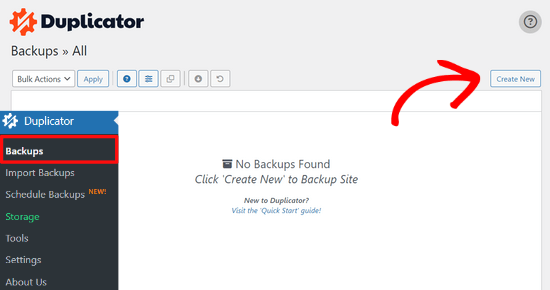
Bu sizi yedeklemenize bir ad verebileceğiniz bir ekrana getirir.
Ardından, ‘İleri’ düğmesine tıklayın.

Duplicator şimdi her şeyin yolunda olup olmadığını görmek için bazı testler yapacaktır.
Tüm öğeler ‘İyi’ olarak işaretlenmişse, ‘Oluştur’ düğmesine tıklayın.

Bu işlem, web sitenizin boyutuna bağlı olarak birkaç dakika sürebilir. İşlem tamamlanana kadar bu sekmeyi açık bırakmalısınız.
Tamamlandığında, ‘Yükleyici’ ve ‘Arşiv’ paketleri için indirme seçenekleri göreceksiniz. Her iki dosyayı da bilgisayarınıza indirmek için ‘Her İki Dosyayı da İndir’ düğmesine tıklamanız gerekir.

‘Arşiv’ dosyası WordPress sitenizin eksiksiz bir kopyasıdır. Tüm WordPress çekirdek dosyalarının yanı sıra resimlerinizi, yüklemelerinizi, temalarınızı, eklentilerinizi ve WordPress veritabanınızın bir yedeğini içerir.
‘Yükleyici’ dosyası, web sitenizi içeren arşiv dosyasını açarak tüm geçiş sürecini otomatikleştirecek bir komut dosyasıdır.
Adım 2: Canlı WordPress Web Siteniz İçin Bir Veritabanı Oluşturun
Yükleyiciyi çalıştırmadan veya WordPress web sitesini localhost’tan hosting sunucunuza yüklemeden önce, yeni canlı web siteniz için bir MySQL veritabanı oluşturmanız gerekir.
Zaten bir MySQL veritabanı oluşturduysanız, bu adımı atlayabilirsiniz.
Bir veritabanı oluşturmak için hosting hesabınızın cPanel kontrol panelini ziyaret etmeniz gerekir. Ardından, ‘Veritabanları’ bölümünü bulun ve ‘MySQL Veritabanı Sihirbazı’ simgesine tıklayın.
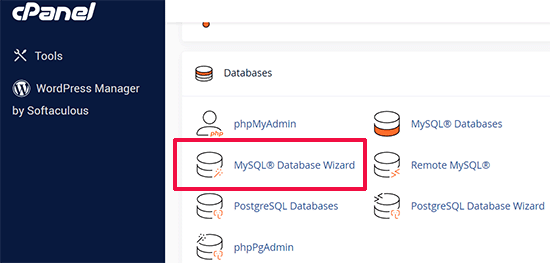
Bir sonraki ekranda, yeni bir veritabanı oluşturmak için bir alan vardır.
Veritabanınız için bir ad girin ve ‘Veritabanı Oluştur’ düğmesine tıklayın.

cPanel şimdi sizin için yeni bir veritabanı oluşturacaktır.
Bundan sonra, yeni kullanıcınız için bir kullanıcı adı ve şifre girmeniz ve ardından ‘Kullanıcı Oluştur’ düğmesine tıklamanız gerekir.
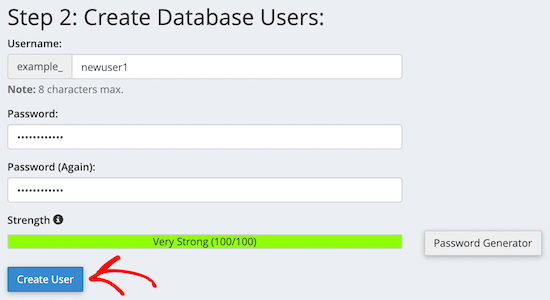
Ardından, yeni oluşturduğunuz kullanıcıyı veritabanına eklemeniz gerekir.
İlk olarak, ‘Tüm Ayrıcalıklar’ onay kutusunu tıklayın.
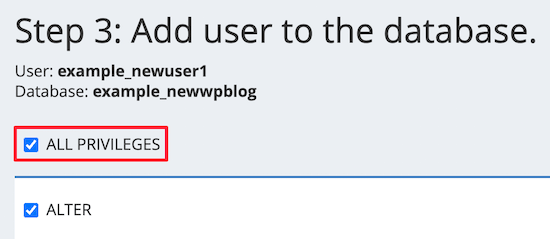
Ardından, aşağı kaydırın ve değişikliklerinizi kaydetmek için ‘Değişiklik Yap’ düğmesine tıklayın.
Veritabanınız artık WordPress sitenizle birlikte kullanılmaya hazırdır. Veritabanı adını, kullanıcı adını ve parolayı not ettiğinizden emin olun. Bu bilgilere bir sonraki adımda ihtiyacınız olacak.
Adım 3: Dosyaları Yerel Sunucudan Canlı WordPress Web Sitesine Yükleyin
Şimdi, arşiv ve yükleyici dosyalarını yerel sitenizden barındırma hesabınıza yüklemeniz gerekir.
İlk olarak, bir FTP istemcisi kullanarak canlı sitenize bağlanın. Bağlandıktan sonra, web sitenizin kök dizininin tamamen boş olduğundan emin olun.
Normalde kök dizin /home/public_html/ klasörüdür.
Bazı WordPress barındırma şirketleri, kaydolduğunuzda WordPress’i otomatik olarak yükler. Eğer orada WordPress dosyalarınız varsa, onları silmeniz gerekir.
Bundan sonra, archive.zip ve installer.php dosyalarını Duplicator’dan boş kök dizininize yükleyebilirsiniz.

Adım 4: Geçiş Komut Dosyasını Çalıştırma
Geçiş dosyalarını yükledikten sonra, tarayıcınızda aşağıdaki URL’yi ziyaret etmeniz gerekir:
http://example.com/installer.php
‘example.com’ yerine kendi alan adınızı yazmayı unutmayın.
Bu, Duplicator geçiş sihirbazını başlatacaktır.
Yükleyici birkaç test çalıştıracak ve komut dosyasını başlatacaktır.
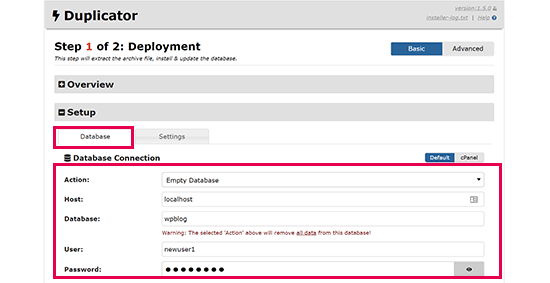
Kurulum bölümü altında, MySQL ana bilgisayarınızı, veritabanı adınızı, kullanıcı adınızı ve şifrenizi girmeniz istenecektir.
Ana bilgisayarınız muhtemelen yerel bir ana bilgisayar olacaktır. Bundan sonra, bir önceki adımda oluşturduğunuz veritabanının ayrıntılarını gireceksiniz.
Ardından, girdiğiniz bilgilerin doğru olduğundan emin olmak için ‘Doğrula’ düğmesine tıklayın.
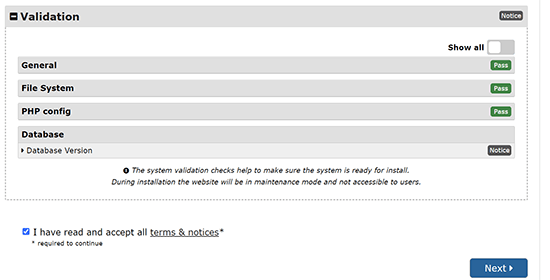
Bundan sonra, devam etmek için ‘İleri’ düğmesine tıklayın.
Duplicator şimdi WordPress veritabanı yedeğinizi arşivden yeni veritabanınıza aktaracaktır.
Ayrıca yerel siteye ve yeni canlı sitenize işaret eden URL’leri de güncelleyecektir.
Artık canlı sitenizin WordPress yönetici alanına girmek için ‘Yönetici Girişi’ düğmesine tıklayabilirsiniz.

Canlı sitenizde oturum açtığınızda, Duplicator kurulum dosyalarını otomatik olarak temizleyecektir.
Hepsi bu kadar. WordPress’i yerel sunucudan canlı sitenize başarıyla taşıdınız.
Yöntem 2: WordPress’i Yerel Sunucudan Canlı Siteye Manuel Olarak Aktarın
Bu yöntemde, WordPress’i yerel sunucudan canlı sitenize manuel olarak nasıl taşıyacağınızı göstereceğiz. İlk yöntem işe yaramazsa veya manuel olarak yapmayı tercih ederseniz faydalı olacaktır.
Adım 1: Yerel WordPress Veritabanını Dışa Aktarın
Yapmanız gereken ilk şey yerel WordPress veritabanınızı dışa aktarmaktır. Bunu yapmak için phpMyAdmin kullanacağız.
Eğer bu konuda bilginiz yoksa, phpMyAdmin kullanarak WordPress veritabanı yönetimi rehberimize göz atmak isteyebilirsiniz.
Basitçe http://localhost/phpmyadmin/ adresine gidin ve WordPress veritabanınıza tıklayın. Ardından, üst menü çubuğundan ‘Dışa Aktar’ düğmesine tıklayın.

‘Dışa aktarma yöntemi:’ seçeneğinde, ‘Hızlı’ veya ‘Özel’i seçebilirsiniz. Özel, veritabanınızı dışa aktarmak için size daha fazla seçenek sağlayacaktır.
Ancak veritabanınızı indirmek için ‘Hızlı’yı seçmenizi ve ardından ‘Git’ düğmesine tıklamanızı öneririz.

Adım 2: WordPress Dosyalarını Canlı Siteye Yükleyin
Şimdi, tüm web sitesi dosyalarınızı canlı siteye taşımamız gerekecek.
Başlamak için FTP istemcinizi açın ve web barındırma hesabınıza bağlanın.
Canlı sitenize bağlandıktan sonra, dosyaları doğru dizine yüklediğinizden emin olun. Örneğin, sitenin ‘yoursite.com’ adresinde barındırılmasını istiyorsanız, tüm dosyaları public_html dizininize yüklemek isteyeceksiniz.
Şimdi yerel WordPress dosyalarınızı seçin ve canlı sunucunuza yükleyin.
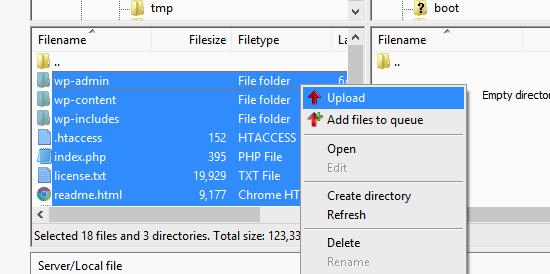
Adım 3: Canlı Sitenizde MySQL Veritabanı Oluşturun
FTP istemciniz WordPress dosyalarınızı yüklerken, veritabanınızı canlı sunucuya aktarmaya başlayabilirsiniz.
Çoğu WordPress barındırma sağlayıcısı, barındırma hesabınızı yönetmek için cPanel sunar, bu nedenle size cPanel kullanarak nasıl veritabanı oluşturacağınızı göstereceğiz.
Öncelikle, cPanel panonuza giriş yapmanız ve ‘Veritabanları’ bölümünde bulunan ‘MySQL Veritabanı Sihirbazı’ simgesine tıklamanız gerekir.

Bir sonraki ekranda yeni bir veritabanı oluşturabilirsiniz.
Veritabanınız için bir ad girmeniz ve ardından ‘Veritabanı Oluştur’a tıklamanız gerekir.

cPanel şimdi sizin için otomatik olarak yeni bir veritabanı oluşturacaktır.
Ardından, yeni kullanıcınız için bir kullanıcı adı ve şifre girmeniz ve ardından ‘Kullanıcı Oluştur’a tıklamanız gerekir.
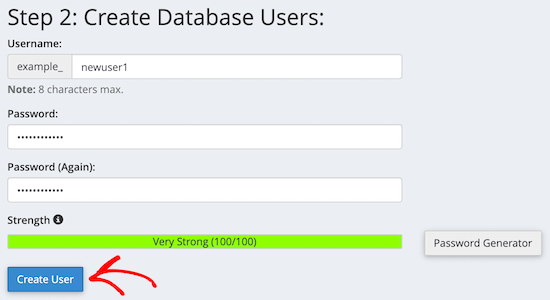
Bundan sonra, yeni oluşturduğunuz kullanıcıyı veritabanına eklemeniz gerekir.
İlk olarak, ‘Tüm Ayrıcalıklar’ onay kutusunu işaretleyin.
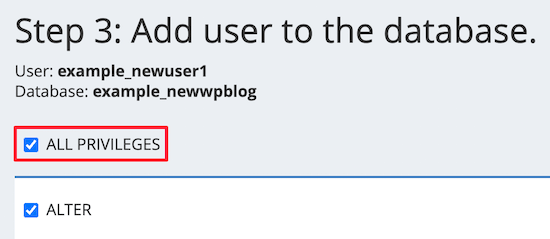
Ardından, aşağı kaydırın ve değişikliklerinizi kaydetmek için ‘Değişiklik Yap’a tıklayın.
Canlı WordPress siteniz için başarıyla yeni bir veritabanı oluşturdunuz.
Adım 4: WordPress Veritabanını Canlı Siteye Aktarın
Süreçteki bir sonraki adım WordPress veritabanınızı içe aktarmaktır.
cPanel panonuza gidin, ‘Veritabanları’ bölümüne ilerleyin ve ‘phpMyAdmin’e tıklayın.
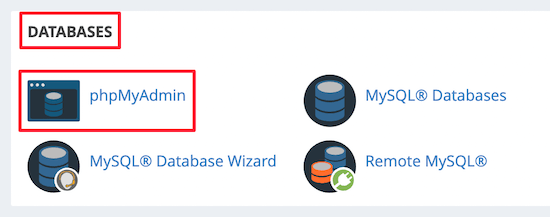
Bu sizi phpMyAdmin’e götürecektir, burada yukarıda oluşturduğunuz veritabanına tıklamak isteyeceksiniz. phpMyAdmin yeni veritabanınızı tablolar olmadan gösterecektir.
Ardından, üst menüdeki ‘İçe Aktar’ sekmesine tıklayın. İçe aktarma sayfasında, ‘Dosya Seç’ düğmesine tıklayın ve ardından ilk adımda kaydettiğiniz yerel sitedeki veritabanı dosyasını seçin.
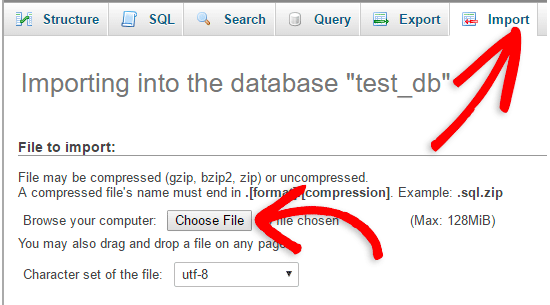
Bundan sonra, sayfanın altındaki ‘Git’ düğmesine tıklayın. Veritabanınız otomatik olarak phpMyadmin’e aktarılacaktır.
Adım 5: Site URL’sini Değiştirin
Şimdi, canlı WordPress sitenize bağlanması için veritabanınızdaki site URL’sini değiştirmeniz gerekir.
phpMyAdmin’de, yukarıda içe aktardığınız veritabanınızdaki wp_options tablosunu arayın.
Veritabanı önekinizi değiştirdiyseniz, wp_options yerine {new_prefix}_options olabilir.
Ardından, wp_options öğesinin yanındaki ‘Gözat’ düğmesine tıklayın. Ya da wp_options tablosundaki alanların bir listesini içeren sayfayı açmak için kenar çubuğundaki bağlantıya tıklayın.
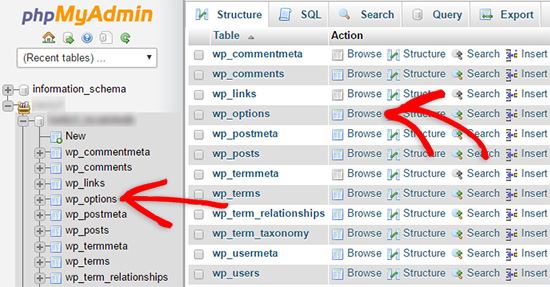
Ardından, options_name sütununda siteurl seçeneğini aramanız gerekir.
Ardından, ‘Düzenle’ simgesine tıklayın.

Bu, alanı düzenleyebileceğiniz bir pencere açar.
option_value giriş kutusunda, yerel yüklemenizin URL’sini göreceksiniz; bu URL http://localhost/test gibi bir şey olacaktır.
Bu alana yeni sitenizin URL’sini girmeniz gerekir, örneğin: https://www.wpbeginner.com.
Ardından, ‘Git’ düğmesine tıklayarak alanı kaydedebilirsiniz.
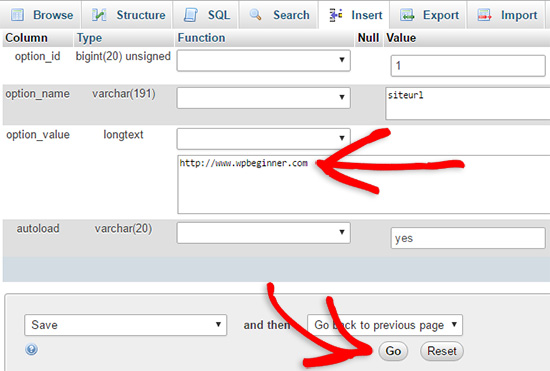
Ardından, ana sayfa seçeneği adı için yukarıdaki adımların aynısını izlemeniz gerekir. wp_options menüsü birkaç sayfa uzunluğunda olabilir. Genellikle, ana sayfa seçeneği ikinci sayfada olacaktır.
Ardından, ana sayfa URL’sini güncelleyin, böylece canlı site URL’nizle aynı olur.
Adım 6: Canlı Sitenizi Kurun
Veritabanını içe aktardığınıza ve içeriğinizi yüklediğinize göre sıra WordPress’i yapılandırmaya geldi.
Şu anda sitenizde‘Veritabanı bağlantısı kurulurken hata oluştu’ hatası görünüyor olmalıdır.
Bunu düzeltmek için, bir FTP istemcisi kullanarak web sitenize bağlanın ve wp-config.php dosyasını açın.
Aşağıdaki kod satırlarını arıyor olacaksınız:
1 2 3 4 5 6 7 8 9 | // ** MySQL settings - You can get this info from your web host ** ///** The name of the database for WordPress */define( 'DB_NAME', 'database_name_here' );/** MySQL database username */define( 'DB_USER', 'username_here' );/** MySQL database password */define( 'DB_PASSWORD', 'password_here' );/** MySQL hostname */define( 'DB_HOST', 'localhost' ); |
Daha önce oluşturduğunuz veritabanı adını, kullanıcı adını ve parolayı sağlamanız gerekecektir.
Ardından, wp-config.php dosyasını kaydedin ve WordPress barındırma sunucunuza geri yükleyin.
Şimdi, web sitenizi ziyaret ettiğinizde canlı olması gerekir.
Bundan sonra, WordPress yönetici panelinize giriş yapmanız ve Ayarlar ” Genel bölümüne gitmeniz gerekir. Ardından, hiçbir şeyi değiştirmeden en alta kaydırın ve ‘Değişiklikleri Kaydet’ düğmesine tıklayın.
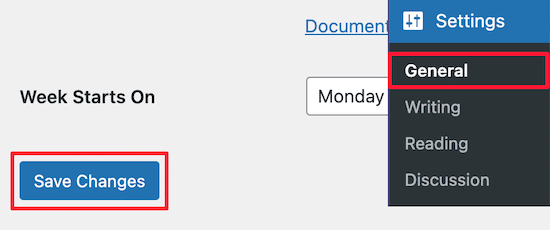
Bu, sitenizin URL’sinin olması gereken başka bir yerde düzeltilmesini sağlayacaktır.
Bunu yaptıktan sonra, Ayarlar ” Kalıcı Bağlantılar’a gidin, ardından aşağı kaydırın ve tüm gönderi bağlantılarının düzgün çalıştığından emin olmak için ‘Değişiklikleri Kaydet’e tıklayın.

Adım 7: Yolları Güncelleyerek Görüntüleri ve Bozuk Bağlantıları Düzeltin
Bir WordPress sitesini bir etki alanından diğerine veya yerel bir sunucudan canlı bir siteye taşıdığınızda, kırık bağlantılar ve eksik görüntülerle karşılaşırsınız.
URL’leri güncellemek için size iki yol göstereceğiz. Sizin için en uygun olanı seçebilirsiniz.
1. Search & Replace Everything Eklentisini Kullanarak URL’leri Güncelleyin (Önerilen)
Bunu düzeltmenin en güvenli yolu Search & Replace Everything kullanmaktır. Karmaşık veritabanı sorguları yazmadan web sitenizde toplu güncelleme görevlerini kolayca gerçekleştirmenizi sağlayan güçlü bir WordPress eklentisidir.
İlk olarak, Search & Replace Everything eklentisini yüklemeniz ve etkinleştirmeniz gerekir.
Etkinleştirmeden sonra Araçlar ” WP Search & Replace sayfasına gidin.
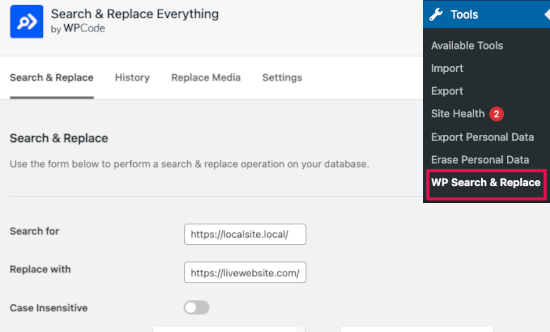
Buradan, yerel site URL’nizi ‘Ara’ alanına ve canlı site URL’nizi ‘Şununla değiştir’ alanına girmeniz gerekir.
Biraz kaydırın ve tabloların altındaki ‘Tümünü Seç’ seçeneğine tıklayın. Bu, eklentinin veritabanındaki her yerde eski URL’yi aramasını sağlar.

Şimdi devam etmek için ‘Arama ve Değiştirmeyi Önizle’ düğmesine tıklayın.
Eklenti, veritabanınızda eski URL’nin tüm örneklerini arayacak ve ardından sonuçları önizleyecektir.
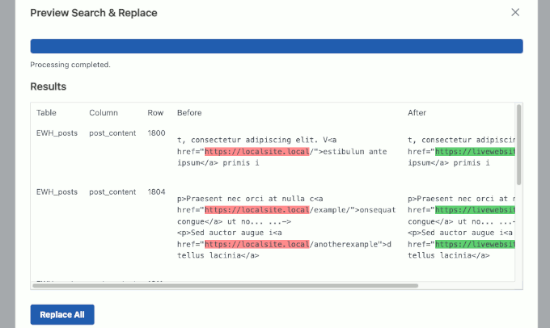
Her şey iyi görünüyorsa, değişiklikleri kaydetmek için ‘Tümünü Değiştir’e tıklayın.
Yaptığınız değişiklikler hakkında bir uyarı göreceksiniz. Devam etmek için ‘Evet’e tıklayın.
Eklenti şimdi veritabanını güncelleyecek ve yerel URL’leri mevcut web sitenizin URL’si ile değiştirecektir.
2. URL’leri Manuel Olarak Güncelleme (Gelişmiş)
URL’leri güncellemenin bir başka yolu da aşağıdaki SQL sorgusunu kullanmaktır:
1 | UPDATE wp_posts SET post_content = REPLACE(post_content, 'localhost/test/', 'www.yourlivesite.com/'); |
Basitçe phpMyAdmin‘e gidin, veritabanınıza tıklayın ve ardından üst menüden ‘SQL’e tıklayın ve yukarıdaki sorguyu ekleyin.
Yerel siteniz ve canlı site URL’leri olarak değiştirdiğinizden emin olun ve ‘Git’ düğmesine tıklayın.
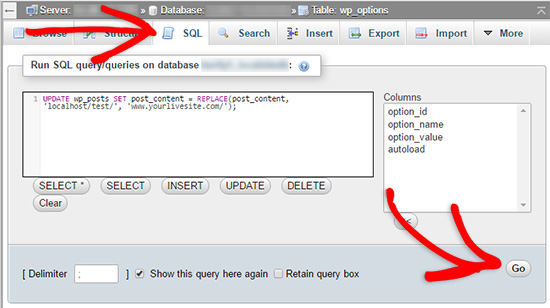
İşte bu kadar. Artık WordPress’i yerel sunucunuzdan canlı bir siteye başarıyla geçirdiniz.
Umarım canlı web siteniz sorunsuz bir şekilde çalışır. Herhangi bir hata fark ederseniz, sorun giderme konusunda yardım almak için yaygın WordPress hataları kılavuzumuza göz atabilirsiniz.
Umarız bu makale WordPress’i yerel bir sunucudan canlı bir siteye taşımanıza yardımcı olmuştur. Ayrıca canlı bir siteyi yerel bir sunucuya taşıma kılavuzumuzu görmek veya pratik WordPress taşıma adımları için nihai web sitesi taşıma kontrol listesine bakmak isteyebilirsiniz.
If you liked this article, then please subscribe to our YouTube Channel for WordPress video tutorials. You can also find us on Twitter and Facebook.





James
Hi!
Any tips on how I can fix a broken link that is still using localhost for a calendar plugin that I installed?
James
Karl
I’ve bookmarked this page in the past for future reference after I had migrated my own site about a year ago. I dragged my feet getting backupbuddy and now, wow! That plugin is a bit too much for my budget. Will most likely use duplicator to migrate their site redesign from MAMP to live.
Unfortunately, the client’s current WP install is a mess. I’m counting 6 db from previous and current site designs. I’m guessing it would be easier for me to just sweep clean all the old dbs (delete) and create a new one for my migration rather than trying to run duplicator and then have to wade through with phpmyadmin to fix any problems.
I’ll keep this page up in my browser, just in case during migration, but I wish there was a way just to overwrite the current db with my redesign db without a need to then jump back in and make changes (via phpmyadmin). Would make the migration smoother.
Too bad backupbuddy has raised their prices.
fatemeh
Hello \
I have followed all the steps but there is nothing shown on my website , I dont know whats wrong , I do appreciate your help.
Forbidden
You don’t have permission to access / on this server.
Additionally, a 403 Forbidden error was encountered while trying to use an ErrorDocument to handle the request.
This is an error I got,
Thank you
WPBeginner Support
Please see our guide on how to fix the 403 forbidden error in WordPress.
Admin
Ian
I really appreciated this tutorial – thanks. And following it to the letter has really helped solve most of my issues. However there is one that remains. The “live” site appearance looks very much like the “localhost” site, with one exception. When I go to the Dashboard and “edit” a page live, none of the text normally visible is available for me to edit. When I go to “Preview Changes” it shows a blank screen. Is there another flaw in the database structure I have missed in the conversion/upload process? Can you show me where I might have gone wrong for this to happen please? Ian
WPBeginner Support
Try updating your permalink structure. Simply visit Settings » Permalinks and then click on the save changes button without changing anything.
Admin
peter
After importing the local database to live server, my cpanel phpadmin is not working. cant access it anymore.please help
HTTP error 404
The requested page was not found.
Possible reasons why you are seeing this page:
A bookmarked URL may have changed since you last visited.
The URL was entered incorrectly.
The URL was entered with inaccurate capitalization (URLs are case sensitive).
Please re-check the URL you are trying to reach. (Go Back)
Copyright© 2016 cPanel, Inc.
WPBeginner Support
Please contact your WordPress host for support, they will be able to help you better.
Admin
Rajeev
Hi, this tutorial has worked very well and I have migrated a locally hosted wordpress site on to GoDaddy webhosting services however when I try to log in to my website (wp-admin) it redirects to a 404 error. Any suggestions on why this is happening and what to do to solve this?
Thanks
WPBeginner Support
Have you changed site URL? Remember http://www.example.com and example.com are considered two different domains. Also make sure that you haven’t installed WordPress in its own subdirectory. In that case, your wp-admin login url will be something like example.com/wordpress/wp-admin/
Admin
Vinish Chaudhary
Hello Rajeev,
Did you find the solution for this 404 error?
Gerald
Hi Syed,
I did all that was required and encountered a HTTP ERROR 500 with the notification “…currently unable to handle this request”. I’m not sure if it’s the theme I’m using that has a problem. It’s worked fine for me on another web server.
Ant recommendations on how to fix this?
The server seems to be running on php 5.5 while my localhost ran version 5.6. Does this affect it in anyway?
WPBeginner Support
Try steps mentioned in our guide on how to fix the internl server error in WordPress.
Admin
vinay
after completing 5th step when i go to the link mysit/wp-admin for next step I get these error plz help
This either means that the username and password information in your wp-config.php file is incorrect or we can’t contact the database server at . This could mean your host’s database server is down.
i hv alredy udated my wp_config.php
Kasoma
thanks for the post but my log is not displaying and when i click the pages it shows internal server error. please help to fix that
Sharon
Your instructions were great, and love that you provided pictures as well.
However, I am having an issue. I can see my site, I can see the images for the logos and pictures I have added, but the themes are not loading. They are showing up as blank. I am not sure where to start?
When I ran your sql script through my database I get a an error #1146 – Table ‘mcintyre_wp.wp_posts’ doesn’t exist.
Any help would be greatly appreciated!
Owen
This is a great tutorial, easy to follow and gets the job done!
JESH
Hi there, thank you heaps, I have sorted it out. My website domain is now stuck on mywebsitename.preview.services . How do I get rid of the preview.services? I am worried that if I change the URL on WordPress it will stuff everything up and I want to be sure I know what I’m doing. Appreciate the help.
Najeeb
Hi,
Very good tutorial.
I would like to know is it better to design a website on a local wordpress server then upload on a server like hostgator or it is also better to buy a domain on hostgator and create a wordpress website in live environment?
Please let me know i am new to this.
Jesh
Hi there,
absolute frustration has caused me comment for help. I have been trying to upload my site from local to live using MAMP and FileZilla. I have followed your steps as well as others MANY times but still to no avail. Your guide is very good and I have followed the whole thing to the end but every time I go to view my site it comes up with the domain then .preview.services . The page is an “index of” page and it won’t let me go any further. I have tinkered around with the settings but really don’t know what to do except smash my computer. Can you recommend anything? …a sledgehammer?
WPBeginner Support
When uploading files from your computer to your website, make sure you are uploading them in the correct directory. If you are not sure, then ask your web hosting service provider. Typically its called /public_html/ but it varies from one web host to another.
Also make sure that you are uploading only your WordPress files and not including the MAMP files and directories in the upload.
Admin
Gale
Just wanna let you know, you guys are freaking awesome! This is such a great tutorial! I’d been stuck for days with the links not working and you’re the only ones mentioning saving the settings! Thank you so much!
Rajat
Hi,
I just started using Hostgator. I had created a website using WAMP. I have the .sql file and the wordpress files. I am still not able to get that website show up on my domain. Can you please tell me what can i do in this regard.
Thanks for your help.
Gary Pippin
Hi,
I have created a wordpress website and it is still not live. When i open the url in browser it says “This url is under construction : Coming Soon”.. Could you please help me with this issue.
Thanks
Gary
WPBeginner Support
1. Your site may have a plugin installed that is used to display this page.
2. Your domain name may not be pointing to the directory where you have your WordPress site.
Please contact your web host, they will be able to help you better.
Admin
nick
i dont get it. like my site is live but it still have broken links and images. im trying to fix it with the my sql quary way but everything i fill in as local site and live site URLs it says 0 rows affected and theres nothing that changed. So can you explain which urls i have to fill in exactly
Julian
Hello Nick,
Are you using the query on the live phpmyadmin dashboard?
Make sure you do it on the live site through Cpanel and not on your local environment.
Kishokumar
Great word buddy, i didn’t know about this until now. Thank you so much.
Learner
Hi, I’m learnin wordpress, I’m trying to migrate my website to a new domain and new host. Should I need to activate wordpress on my new hosting account before I load from my backup website. Thanks for your help.
WPBeginner Support
Depends on what kind of backup you have. If it is an XML or RSS file, then you should first install WordPress and then import your content from those files. If the back contains database and complete WordPress files, then you need to extract and upload WordPress files to your new host and then import database from backup.
Admin
Priyangga
All works great!! but the theme doesn’t completely loaded, is the any issues? please help!!
Yuri
Thanks for the article, but ima kinda desperate here…
Lost 4 hours of working trying to figure out why in my webserver the index page keeps BLANK, even after connected the database. And my admin page gives me the error not found, i’ve been searching for a solution and nothing helps.
thanks in advance
Steve
Worked perfectly! Thanks.
Croiche Jim
thanks a lot
cheers!
precious osasumwen
pls help. i get this error when i try to access my phpadmin in my wamp server.
phpMyAdmin – Error
Cannot start session without errors, please check errors given in your PHP and/or webserver log file and configure your PHP installation properly. Also ensure that cookies are enabled in your browser.
what do i do sir
Sneha
Hi,
I have created my website on my local server and also I have used action method to navigate to different pages. But on these action methods I have given localhost permalinks only as destination address. So do I have to replace it with live address everywhere in the code or is there some method by which i can replace it at once.
Chris Cal
I’m not one to usually comment but this is an excellent post.
Great work Syed and team. Greatly appreciated.
Cheers, Chris.
WPBeginner Support
Thanks, we are glad you found it helpful.
Admin
Leslie
It was the .htaccess file!!! But I had to upload a completely new file. Thanks!!!
Courtney
Any tutorials for when you have forgotten your phpMyAdmin login info? I am stuck at the beginning! It has been a while since I have needed to login and cannot for the life of me remember. I used this site as a tutorial to set up but cannot figure out how to reset. I have seen some tutorials to reset but I am afraid it is going to mess things up as I am not an expert. Any suggestions or tutorials you can point me to? TIA
WPBeginner Support
You can login to phpMyAdmin from your hosting control panel as well.
Admin
Tyane
I’m stuck on step 6. I edited the wp-config. file and uploaded it. It gave me six errors, with most of them beginning with, ” unexpected beginning of statement” followed by the position each error is listed. I’m very new to this and my IT husband is out of town till Friday.
barshan hassan
Thanks… I love u
leon
works really well!
geeuy
great tutorial!
worked like a charm!
ashkan
hi there tnx for this article
i did all these steps and my site is up now but when i click on other pages or links i faced this eror
(Internal Server Error)
in fact I just can see the homepage
can You tell me about This?
Thatguy91
I had the same issue, go to the permalinks page and click the save button. I think it needs to “resave” the permalinks again somewhere once migrated.
mtahirian
Hello,
I have uploaded my site live. but unfortunately i can’t go to wordpress admin. the wordpress admin is working fine on local server. it has problem keep telling that : Warning: Cannot modify header information – headers already sent by (output started at /home/………/public_html/wp-content/plugins/js_composer_theme/js_composer.php:1) in /home/porseshresearch/public_html/wp-includes/pluggable.php on line 1228
Please Help
WPBeginner Support
Seems that js_composer_theme plugin is not working. Connect to your website using FTP and then download the plugin to your computer. After that you can delete the plugin from your server. This should resolve the issue.
Admin
mtahirian
Thanks for responding.
I did, as told. but the whole site is smashed up and can’t get the design correct. I need the COMPOSER.
wpbeginner
Thank you very much for your wonderful tutorial.
I am having a problem where my website is only accessible through blog.example.com but not accessible through example.com/blog
May I know what can be done to solve this?
WPBeginner Support
Your blog is hosted as a subdomain. You will need to export it to your main domain.
Admin
wpbeginner
My subdomain folder is in public_html folder.
May I know where should I export it for it to be in my main domain?
Your help is greatly appreciated.
awoyemi ayomide
thanks it help me a lot
Lars Breum Hansen
I am stuck at step 6. My site is live, but instead of going to my main page, It show my themes default main page, at gives me an 404 (because it can’t find posts, but my main page is set to be static). And I can’t login as admin, becuase then it gives me the 500 internal error?
Kim Macc
Hi.
This article is great thank you!! I have done everything and the site is live but the pages are not linking/working i get an ‘internal server error’
please help me fix this as soon as possible. have done the SQL query but to no avail.
AP
Make sure hidden files are copied over as well as part of Step 2
Ebune
i had a problem in the step where i am to change localhost/test. to my site name. i cant really see an edit but to change that stuff. also, when i try to upload my database, it gives me an error. please can anyone help??? am in a deep shit right now
Dang Ng
You could try writing an SQL statement to modify that cell and see what MySQL say
Mayur
My website is
I have changed my server , i took backup of wp files and mysql before my server service expired. Now i am on a new server, uploaded and extracted wp files in public_html, i am. Getting an error – error establishing database connection, hoe should i solve this error?
WPBeginner Support
Please take a look at how to fix the error establishing a database connection in WordPress.
Admin
Caitlin
Hi! I ran into a problem in step 6: “To fix this, connect to your website using an FTP client and edit wp-config.php file. Provide the database name, user and password you created earlier in Step 3. Save the wp-config.php file and upload it back to your server. Visit your website, and it should be live now.”
I did that and it didn’t work, so I started to edit where it said “localhost” and changed it to my domain.
I’m a totally newbie so any help would be appreciated!
WPBeginner Support
Try using localhost as your MySQL Host
define( ‘DB_HOST’, ‘localhost’ );
Admin
ananta
owh… maan… this is what i am looking for all day long… finally found your article. it’s very helpful. now, my site is live. thank you. good work by the way.
Raj jain
Hi,
How can I solve this error. Reply urgently.
Fatal error: Allowed memory size of 67108864 bytes exhausted (tried to allocate 32 bytes) in /home/sitename/public_html/wp-includes/pomo/mo.php on line 236
WPBeginner Support
See our guide on how to fix WordPress memory exhausted error.
Admin
Elise
Hello, I’ve been following all these steps but when I’m doing the export but when I’m importing in my OVH database I can only see wp_commentmeta and wp_comments instead I’ve selected all tab during the export and choose custom and the gzipped format
Do you know what’s happening here?
Amey mankar
Thank You so much. It help me alot.
Mboule A
I tried changing localhost to my domain name but it isn’t going. I need help. I’ve tried both methods. Both the plugins and using the SQL code
Bessong william
thanks you for you tutorial, but am still a beginner in web developping, i need you to teach me with a plugin like BackupBuddy or Duplicator or what ever!!!, how to migrate my website from local to live production site
cmunozro
Can’t access my website.
Error al establecer una conexión con la base de datos (unable to connect to data base)
I try accessing thorough the IP as the domain is not transfered yet. I’m not sure in the wp_options and in wp_config what data should I use.